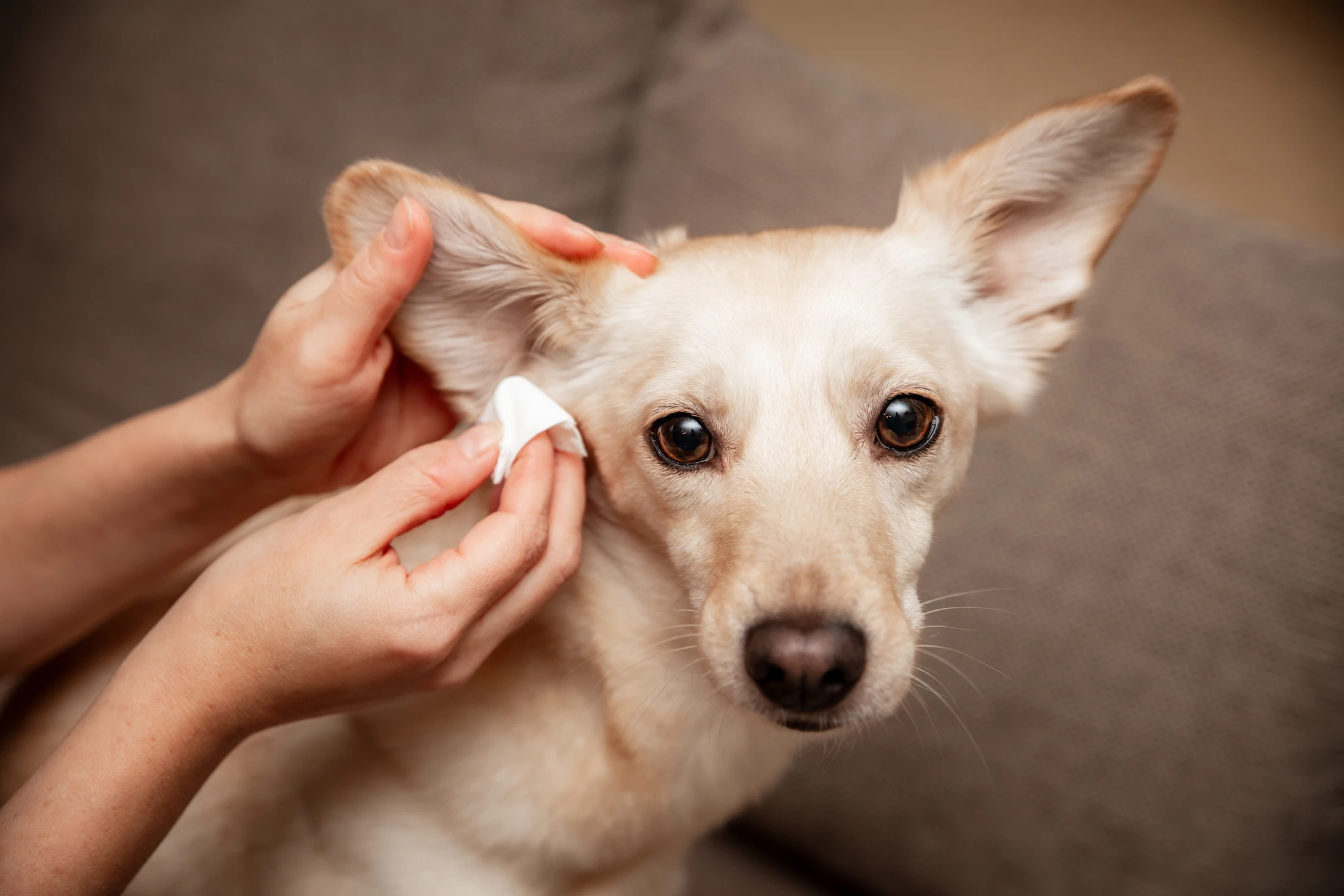Ear mites are microscopic parasites that live in the ear canals of dogs. The most common type, Otodectes cynotis, feeds on earwax and skin oils, causing intense itching and irritation. They’re often spread between pets through close contact and can multiply rapidly without treatment.
While you might not see the mites themselves, you’ll often notice signs of discomfort first, like head shaking or frequent scratching. Puppies and dogs with weaker immune systems are especially vulnerable.
How Ear Mite Infections Happen
Ear mites spread easily, especially in shared environments, like:
- During playtime at the park
- At doggie daycare or grooming appointments
- From other pets in your household (especially cats)
- In shelters or boarding spaces
- From a mother dog to her puppies while nursing
Once inside the ear, the mites feed, reproduce, and multiply quickly. What starts as a small issue can become a more serious infestation without treatment.
Signs of Ear Mites in Your Dog’s Ears
Symptoms may start small but often become more noticeable as the infestation progresses.
Excessive Scratching and Itchy Ears
If your pup seems constantly uncomfortable or scratches their ears more at night, it could be due to ear mites. Nighttime scratching is common because mites tend to be more active after dark.
Changes in Your Dog’s Ear Canals
You might noticea dark, crumbly discharge that looks like coffee grounds, which is usually a telltale sign of mites. The ear canal might look red, swollen, or irritated, and your dog may develop a strong odor or even scabs or sores from scratching.
Other Symptoms to Watch For
- Frequent head shaking
- Holding one ear lower than the other
- Hair loss and open sores around the ears from constant scratching
- A change in mood or behavior due to discomfort
Treating Ear Mites in Dogs
Treatment typically involves a few important steps to clear out mites and help the ears heal. The process can take several weeks, as it’s important to eliminate all life stages of the mites and address any related infections.
Properly Clean Your Dog’s Ears
Cleaning removes debris and helps medications work better. Always use a veterinarian-approved ear cleaner; never water, apple cider vinegar, or hydrogen peroxide, which can cause further irritation.
- Gently massage the base of the ear to loosen debris
- Use a cotton ball (not a swab) to wipe away any buildup
- Always clean both ears, even if only one shows symptoms
Follow your vet’s guidance on how often to clean during treatment.
Use Medications for Mite Infections
Prescription treatments from your care team are safe and effective. These may come as ear drops, oral medications, or injections. Many include ingredients like selamectin or moxidectin, which help eliminate mites and prevent reinfestation.
But be sure to follow the full course of treatment, even if your dog seems better before it’s finished.
Address Secondary Ear Infections
While both mites and infections cause similar symptoms, like itching, redness, and discharge, they aren’t the same and require different treatments. Ear mites are parasitic infestations requiring anti-parasitic medications. Ear infections are due to the presence of bacteria and/or yeast in the ears secondary to ear mites, allergies, or water activities, like baths or swimming, and need different approaches.
These secondary infections can make your dog more uncomfortable and may cause:
- Increased pain or sensitivity
- Swelling
- Yellow-green discharge
- A strong or unpleasant odor
- Thick brown buildup in the ear
Your vet will prescribe medicated ear drops to address the secondary bacterial/yeast infection and, in some cases, oral steroids to help reduce inflammation and promote healing.
Because ear mites and infections often occur together, treating both at the same time supports faster, more complete recovery. Keep a close eye on your pup’s progress and reach out to your care team if symptoms don’t improve within a few days.
How to Prevent Ear Mites in Dogs
Prevention is always better than treatment. With a few regular habits, you can help reduce your dog’s risk of ear mites.
Keep Your Dog’s Ears Clean
Check your dog’s ears weekly and clean them using a veterinarian-approved ear cleaner. Dogs with floppy ears or those who swim often may need more frequent attention. Dry ears thoroughly after baths or swimming, as moisture promotes mite survival. Also, be sure to use separate cleaning supplies for each pet to avoid cross-contamination.
Catch Mites Early
Look for signs like severe itchiness around the ears, redness, unusual odor, or small amounts of dark discharge. During grooming, gently inspect both ears and note any differences. If your dog suddenly starts shaking their head or scratching more than usual, it’s a good idea to check in with your vet.
Wellness visits are a great time to have your care team inspect your dog’s ears, even if everything seems fine.
Use Home and Vet Care to Defeat Ear Mite Infestations
Ear mites may be tiny, but they can cause a big disruption in your dog’s life. The good news? They’re very treatable. With the right support, you can clear up the infection and get your dog back to feeling like themselves again.
At Petfolk, we’re here to help you every step of the way with trusted care, expert diagnostics, and a team that treats your dog like family. If your pup’s ears seem irritated, don’t wait—book an appointment today. We’re here to help with gentle, expert care that gets your dog back to feeling their best.
Frequently Asked Questions (FAQ):
What Are the Symptoms of Ear Mites in Dogs?
Symptoms of ear mites in dogs include excessive scratching of the ears, open sores around the ears, head shaking, a dark discharge from the ears, and redness or inflammation of the ear canal.
Can Humans Catch Ear Mites from Dogs?
Humans are not commonly affected by ear mites from dogs. Ear mites primarily infest animals such as dogs and cats.
How Do You Perform Ear Mite Treatment?
Treatment typically involves cleaning the dog’s ears and applying a veterinarian-prescribed medication to eliminate the mites. Yeast and bacterial ear infections require a different strategy.
Are Ear Mites Contagious Between Dogs?
Yes, ear mites are highly contagious and can easily spread between dogs, particularly in environments where multiple animals are in close contact.

